
A dune is a landform composed of wind- or water-driven sand. It typically takes the form of a mound, ridge, or hill. An area with dunes is called a dune system or a dune complex. A large dune complex is called a dune field, while broad, flat regions covered with wind-swept sand or dunes with little or no vegetation are called ergs or sand seas. Dunes occur in different shapes and sizes, but most kinds of dunes are longer on the stoss (upflow) side, where the sand is pushed up the dune, and have a shorter slip face in the lee side. The valley or trough between dunes is called a dune slack.
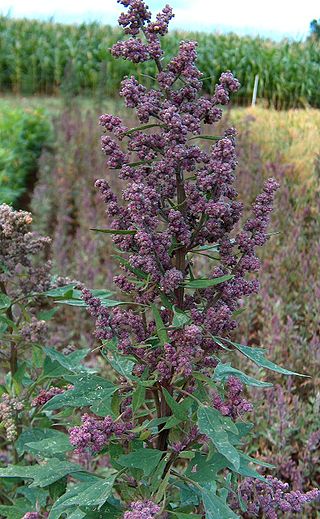
Quinoa is a flowering plant in the amaranth family. It is an herbaceous annual plant grown as a crop primarily for its edible seeds; the seeds are rich in protein, dietary fiber, B vitamins and dietary minerals in amounts greater than in many grains. Quinoa is not a grass but rather a pseudocereal botanically related to spinach and amaranth, and originated in the Andean region of northwestern South America. It was first used to feed livestock 5,200–7,000 years ago, and for human consumption 3,000–4,000 years ago in the Lake Titicaca basin of Peru and Bolivia.

Fynbos is a small belt of natural shrubland or heathland vegetation located in the Western Cape and Eastern Cape provinces of South Africa. This area is predominantly coastal and mountainous, with a Mediterranean climate and rainy winters. The fynbos ecoregion is within the Mediterranean forests, woodlands, and scrub biome. In fields related to biogeography, fynbos is known for its exceptional degree of biodiversity and endemism, consisting of about 80% species of the Cape floral kingdom, where nearly 6,000 of them are endemic. This land continues to face severe human-caused threats, but due to the many economic uses of the fynbos, conservation efforts are being made to help restore it.
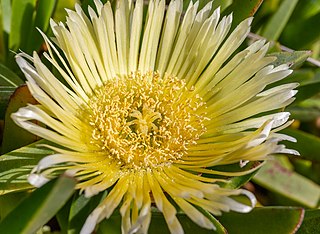
Carpobrotus edulis is a ground-creeping plant with succulent leaves in the genus Carpobrotus, native to South Africa. Its common names include hottentot-fig, sour fig, ice plant or highway ice plant.

The Chenopodioideae are a subfamily of the flowering plant family Amaranthaceae in the APG III system, which is largely based on molecular phylogeny, but were included – together with other subfamilies – in the family Chenopodiaceae, or goosefoot family, in the Cronquist system.

Dysphania ambrosioides, formerly Chenopodium ambrosioides, known as Jesuit's tea, Mexican-tea, payqu(paico), epazote, mastruz, or herba sanctæ Mariæ, is an annual or short-lived perennial herb native to Central America, South America, and southern Mexico.

Chenopodium is a genus of numerous species of perennial or annual herbaceous flowering plants known as the goosefoot, which occur almost anywhere in the world. It is placed in the family Amaranthaceae in the APG II system; older classification systems, notably the widely used Cronquist system, separate it and its relatives as Chenopodiaceae, but this leaves the rest of the Amaranthaceae polyphyletic. However, among the Amaranthaceae, the genus Chenopodium is the namesake member of the subfamily Chenopodioideae.

Chenopodium pallidicaule, known as cañihua, canihua or cañahua and also kaniwa, is a species of goosefoot, similar in character and uses to the closely related quinoa(Chenopodium quinoa).

Chenopodium vulvaria, stinking goosefoot is a foul-smelling plant that grows on bare ground in coastal habitats in the Mediterranean region and is associated with dung heaps and disturbed ground inland. It is native to southern Europe and western Asia and has spread to northern Europe other temperate parts of the world, with agriculture.
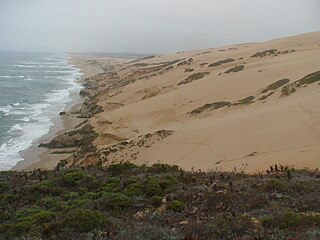
Guadalupe-Nipomo Dunes is the largest remaining dune system south of San Francisco and the second largest in the U.S. state of California. It encompasses an 18-mile (29 km) stretch of coastline on the Central Coast of California and extends from southern San Luis Obispo County to northern Santa Barbara County.

Coastal sage scrub, also known as coastal scrub, CSS, or soft chaparral, is a low scrubland plant community of the California coastal sage and chaparral subecoregion, found in coastal California and northwestern coastal Baja California. It is within the California chaparral and woodlands ecoregion, of the Mediterranean forests, woodlands, and scrub biome.

Ammophila arenaria is a species of grass in the family Poaceae. It is known by the common names marram grass and European beachgrass. It is one of two species of the genus Ammophila. It is native to the coastlines of Europe and North Africa where it grows in the sands of beach dunes. It is a perennial grass forming stiff, hardy clumps of erect stems up to 1.2 metres (3.9 ft) in height. It grows from a network of thick rhizomes which give it a sturdy anchor in its sand substrate and allow it to spread upward as sand accumulates. These rhizomes can grow laterally by 2 metres in six months. One clump can produce 100 new shoots annually.

Sand dune stabilization is a coastal management practice designed to prevent erosion of sand dunes. Sand dunes are common features of shoreline and desert environments. Dunes provide habitat for highly specialized plants and animals, including rare and endangered species. They can protect beaches from erosion and recruit sand to eroded beaches. Dunes are threatened by human activity, both intentional and unintentional. Countries such as the United States, Australia, Canada, New Zealand, the United Kingdom, and Netherlands, operate significant dune protection programs.
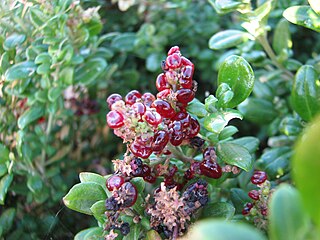
Chenopodium candolleanum, commonly known as seaberry saltbush, is a shrub in the subfamily Chenopodioideae of the family Amaranthaceae, native to Australia.
Chenopodium benthamii is a species of shrub endemic to midwest Western Australia.

Oxybasis chenopodioides is a species of flowering plant in the family Amaranthaceae known by the common name saltmarsh goosefoot. It is native to Europe, Asia and parts of Africa, where it grows on bare mud in brackish hollows in coastal grassland, inland salt steppes and salty deserts. It has spread to similar habitats in both North and South America. Its habitat is an uncommon one and is threatened by agricultural improvement in many areas, but overall its populations are stable. This species often grows with, and is easily confused with the closely-related red goosefoot.

Lupinus nipomensis is a species of lupine known by the common name Nipomo Mesa lupine. It is endemic to the Guadalupe-Nipomo Dunes on the California Central Coast. Specifically, the plant is limited to the Guadalupe Dunes at the southern border of San Luis Obispo County. There are five to seven colonies growing in a strip of sand dunes measuring less than three square miles in area. These colonies are generally considered to make up a single population. The number of individual plants remaining has been observed to vary between 100 and 1,800, its abundance is not correlated to precipitation, is highly variable and exact mechanisms driving abundance unknown. This is a California state and federally listed endangered species.

The Guadalupe-Nipomo Dunes National Wildlife Refuge is a 2,553-acre (10.33 km2) protected area located along the Central Coast of California, in southern San Luis Obispo and northern Santa Barbara Counties.
A foredune is a dune ridge that runs parallel to the shore of an ocean, lake, bay, or estuary. Foredunes consist of sand deposited by wind on a vegetated part of the shore. Foredunes can be classified generally as incipient or established.
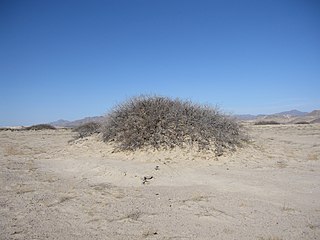
A nabkha, nebkha or nebka is a type of sand dune. Other terms used include coppice dune and dune hummock or hummocky dune, but these more accurately refer to similar, but different, sand dune types. Authors have also used the terms phytogenic hillock, bush-mound, shrub-coppice dune, knob dune, dune tumulus, rebdou, nebbe, and takouit.
















